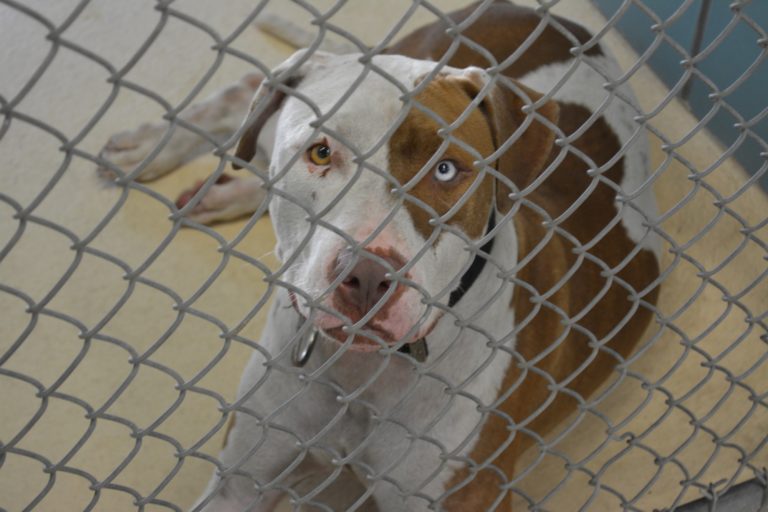
The number of shelter and stray dogs in Hillsborough County has been an issue for years, with pit bull breeds filling the kennels.
At Hillsborough County Pet Resource Center off Falkenburg Road in Tampa, three rooms are lined wall to wall with dog kennels. It’s the only shelter in the entire county.
Anybody can walk back to the rooms. No names or identification required.
Supervision is relaxed, as volunteers come and go, filling water bowls. A man pets a dog through the iron bars. The dog's name is labeled “Unknown.” It's not the only Unknown.
There are 123 dog kennels in the shelter. Sixty-two, rough half, are pit bulls or pit bull mixes.
Walking across the tile floor from kennel to kennel, some dogs dash to the front of their cages, pleading eyes, paws jutting under the metal kennel gate.
Pick me. Pick me. Pick me.

Others stay toward the back. They don’t bother lifting their heads.
In the adoption area, the volunteers are pushing June’s adoption specialty.
Twenty bucks and ten minutes, they say. You can go home with a dog today.
They work off of numbers. The kennel is overpopulated. If a dog or cat goes home, it’s a success.
Pit bulls and pit bull types dominate the kennels nationally too. According to the ASPCA Comprehensive Animal Risk Database System, pit bulls were the number one intake breed out of 45 shelters across the nation in both 2013 and 2014, with 58,270 and 54,415 animals taken in respectively.
According to the same study, pit bulls also were number-one in euthanasia rates, with 30,866 put down in 2013 and 25,135 put down in 2014.
But that’s only out of 45 shelters. According to the American Pit Bull Foundation, 3.5 million pits are put down each year.
While Hillsborough County Pet Resource Center has 123 dogs in its kennel, there are 251 dogs listed on its website.

Out of those, 118 are pit bulls or pit bull types.
Pit Bulls or Florida Browns?
While there are some traits attributed to pit bulls and pit bull types — a muscular, short, stocky body — such dogs are often misidentified. Oftentimes, mislabeled pit bulls or pit bull types are actually the cream-colored cur dogs, more commonly known as the Florida brown dog.
“It’s not as easy as it seems,” Dr. Christy Layton, of Timberlane Pet Hospital in Plant City, said. “While a lot may have some (pit) in them, they may not. DNA is the only way to know for sure.”

In Plant City, apartment complexes including Townsgate, Plantation at Walden Lake, Madison Park and Lakehouse Luxury have breed restrictions, which can leave soon-to-be renters with the task of choosing between a place to live or giving up their “bad” breed. Many times, the dog may actually be the Florida brown breed.
“One of the number one reasons for giving up a pet is, ‘We’re moving,’” Layton said.
The Cycle
Bill Gray runs Second Chance Boxer Rescue Inc. and Second Chance Friends, rescues based in Plant City. While Gray’s home in Plant City is a haven for the Boxer breed, he fosters pit bull and pit bull types, among others, through Second Chance Friends.
Currently, 17 out of the 20 dogs being fostered are pit bull or pit bull types.

“I think it’s a societal problem,” Gray, the founder of Second Chance Boxe said. “Dogs are given away on Craigslist and Facebook. Our elected officials have done nothing. It’s just kind of the wild west out here, and the dogs are the ones that suffer.”
“I think a lot of this is an education issue,” Layton said. “It’s always been this way.”
Part of it, she said, stems from pet owners who fail to spay and neuter their animals. Even those who say they’ll breed just one litter are contributing to the problem.
“Many are driven by money,” Layton said. “One litter can have 12 dogs, so now you have 12 more unwanted dogs in the county than before. There truly is a pet overpopulation problem in our county. If your dog is intact, it’s not an ‘oops’ litter because it could have been prevented.”
At first, things aren’t bad for the new litter of 12 — just the mom, Layton said. She might get dumped.
The puppies get adopted. First come, first serve. The owner of the brood makes a quick few hundred bucks.
Then the puppies start to get older. Without training, they make messes and chew up living room furniture. They get too big for the house or apartment. They go intact and have a litter of their own.
They end up on the street.
They end up at Hillsborough County Pet Resource Center.
They get adopted. Prior to the adoption, Hillsborough County Pet Resource Center spays or neuters the animals, and microchips them. However, some of those animals may have their own litters before they are taken to the shelter.
According to the American Society for the Prevention of Cruelty to Animals, only 10% of animals received by shelters have been spayed or neutered.
Contact Emily Topper at etopper@plantcityobserver.com.
Update 6/25/16: Hillsborough County Pet Resource Center does spay and neuter all animals prior to adoption, unless there is a medical necessity, in which case the animals are spayed/neutered at a later date. The previous version stated that spay/neuter was recommended but not required. We regret the error.
